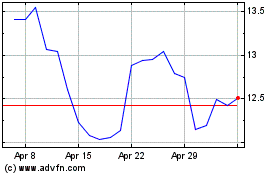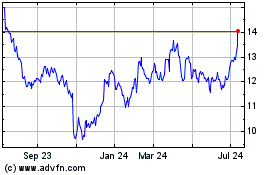By Nora Naughton
The United Auto Workers' new labor deal with Ford Motor Co.
largely mirrors the contract agreement struck with General Motors
Co. last month after a 40-day strike, but with some exceptions.
Unionized workers at Ford will get pay increase, lump-sum
payouts and a path to full-time work for temporary workers --
similar to the gains the UAW won at GM, according to details
released Friday in Detroit. The Ford agreement, which workers still
must ratify, will also match the GM pact in holding employee
health-care contributions at 3% and shortening the time it takes
for new hires to reach the top tier of pay from eight years to four
years.
The UAW also strengthened contract language on the use of
temporary workers in the new Ford contract, requiring the company
to limit its number of temps to 8% of the total workforce and 10%
of the workforce at each plant.
But Ford workers will get a smaller $9,000 signing bonuses if
the contract is approved, and Ford has committed to $6 billion in
new U.S. factory investment, less than amount pledged by GM,
despite having a larger union-represented factory workforce than
its crosstown rival.
The agreement also allows Ford to close an engine plant in
Michigan that now employs 600 workers. Those affected will be
transferred to a nearby transmission plant, resulting in no job
loss, the UAW said.
Labor experts say it is a decent deal for Ford workers, who will
benefit from similar gains as their GM counterparts, but without
having to strike.
"The membership should be satisfied, not happy and tickled to
death," said Art Wheaton, a labor studies professor at Cornell
University. "It'll be ratified but it will probably be somewhat
close."
In 2015, the last time a tentative labor agreement was presented
for a vote, Ford's hourly workers narrowly passed it with 51%
approval. That same year, UAW-represented workers at Fiat Chrysler
voted down their first contract proposal, sending bargainers back
to the table to hash out another deal.
Union leaders will return to their plants this weekend to
present the proposed terms to members. Voting on this latest deal
will begin Monday and wrap up Nov. 15. Ford's UAW-represented
workers must ratify the agreement by a simple majority.
Chris Budnick, 34, a quality inspector at Ford's Kentucky Truck
Plant in Louisville, Ky., said he'd rather Ford commit more money
to its U.S. factories and nix tiered-pay altogether -- as opposed
to doling out big one-time bonuses.
"The bonus is to buy our votes, basically," Mr. Budnick
said.
If they back the deal, the UAW will next move onto negotiations
at Fiat Chrysler Automobiles NV, which labor experts expect to be
more complicated in part because of plans revealed this week for
the auto maker to merger with France's PSA Group.
While GM workers approved a deal to end the longest nationwide
strike at the company since 1970, it isn't immediately clear
whether members will back this latest deal with Ford. A rejection
would mark a significant setback, once again prolonging contract
talks that have already lasted longer than many in the industry
anticipated.
GM set a high bar for its U.S. rivals to meet in this latest
round of bargaining. While GM got the go-ahead to close three U.S.
factories, it also granted the UAW financial gains that will raise
labor costs over next contract's four-year period, analysts
say.
The UAW headed into negotiations with Ford, looking to match the
gains it secured at GM on wages, benefits and other big-picture
economic items.
Ford, in particular, was hoping to win some concessions on
health care at the bargaining table with medical bills for its
unionized workforce expected to top more than $1 billion next
year.
But those prospects dimmed once GM agreed to keep health-care
contributions at 3% -- a far lower rate than the average paid by
other private-sector workers.
Ford's all-in labor costs, which include wages and benefits, are
the second-highest of the Detroit car companies, averaging $61 an
hour this year, according to the Center for Automotive Research.
Foreign-based auto makers, which don't have unionized workforces at
their U.S. plants, spend about $50 an hour on labor costs,
according to the Center.
The Dearborn, Mich., car company is also in the midst of a
massive restructuring, which aims to generate billions in
cost-savings. Once the strongest financially of the Detroit car
companies, Ford has since slipped behind GM in profitability and is
trying to restore earnings growth by closing factories in Europe
and South America and by laying off salaried workers in North
America.
Ford last month dialed back its full-year profit forecast,
citing new cost pressures and a weaker-than-expected fourth
quarter.
Ben Foldy contributed to this article.
(END) Dow Jones Newswires
November 01, 2019 17:11 ET (21:11 GMT)
Copyright (c) 2019 Dow Jones & Company, Inc.
Ford Motor (NYSE:F)
Historical Stock Chart
From Mar 2024 to Apr 2024

Ford Motor (NYSE:F)
Historical Stock Chart
From Apr 2023 to Apr 2024
